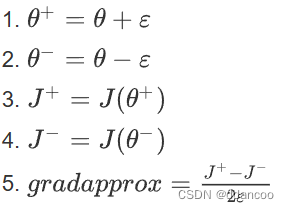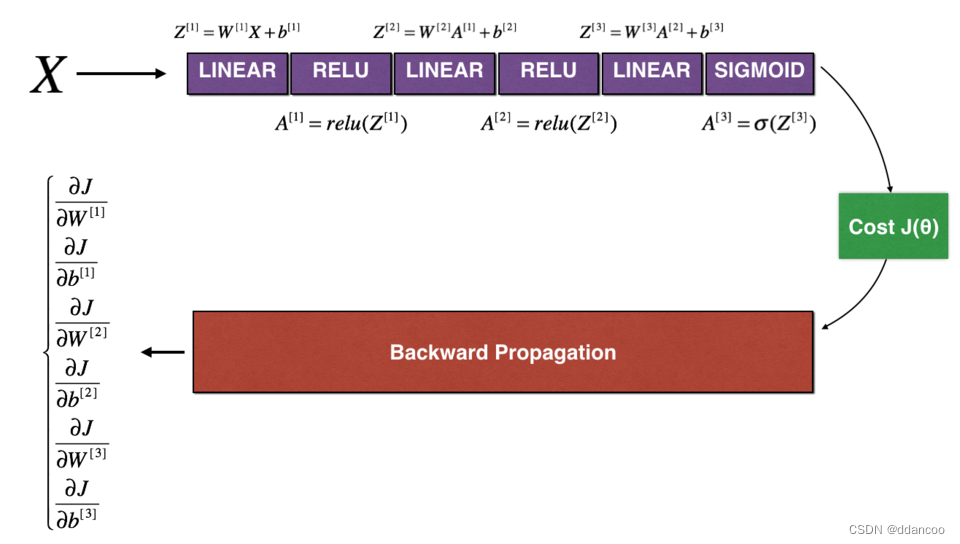梯度检验
欢迎来到本周的最后作业!在本作业中,你将学习实现和使用梯度检验。
假设你是致力于在全球范围内提供移动支付的团队的一员,被上级要求建立深度学习模型来检测欺诈行为--每当有人进行支付时,你都应该确认该支付是否可能是欺诈性的,例如用户的帐户已被黑客入侵。
但是模型的反向传播很难实现,有时还会有错误。因为这是关键的应用任务,所以你公司的CEO要反复确定反向传播的实现是正确的。CEO要求你证明你的反向传播实际上是有效的!为了保证这一点,你将应用到“梯度检验”。
让我们开始做吧!
# Packages
import numpy as np
from testCases import *
from gc_utils import sigmoid, relu, dictionary_to_vector, vector_to_dictionary, gradients_to_vector
1 梯度检验原理
反向传播计算梯度,其中
表示模型的参数。使用正向传播和损失函数来计算
。
由于正向传播相对容易实现,相信你有信心能做到这一点,确定100%计算正确的损失。为此,你可以使用
来验证代码
。
让我们回顾一下导数(或者说梯度)的定义:

如果你还不熟悉""表示法,其意思只是“当
值趋向很小时”。
我们知道以下内容:
是你要确保计算正确的对象。
- 你可以计算
和
在
是实数的情况下),因为要保证
的实现是正确的。
让我们使用方程式和 的一个小值来说服CEO你计算
的代码是正确的!
2 一维梯度检查
思考一维线性函数,该模型仅包含一个实数值参数
,并以
作为输入。
你将实现代码以计算 及其派生
,然后,你将使用梯度检验来确保
的导数计算正确。

图1:一维线性模型
上图显示了关键的计算步骤:首先从开始,再评估函数
(正向传播),然后计算导数
(反向传播)。
练习:为此简单函数实现“正向传播”和“向后传播”。 即在两个单独的函数中,计算 (正向传播)及其相对于
(反向传播)的导数。
# GRADED FUNCTION: forward_propagation
def forward_propagation(x, theta):
"""
Implement the linear forward propagation (compute J) presented in Figure 1 (J(theta) = theta * x)
Arguments:
x -- a real-valued input
theta -- our parameter, a real number as well
Returns:
J -- the value of function J, computed using the formula J(theta) = theta * x
"""
### START CODE HERE ### (approx. 1 line)
J=theta*x
### END CODE HERE ###
return J
练习:现在,执行图1的反向传播步骤(导数计算)。也就是说,计算相对于
的导数。为避免进行演算,你应该得到
=
=
。
# GRADED FUNCTION: backward_propagation
def backward_propagation(x, theta):
"""
Computes the derivative of J with respect to theta (see Figure 1).
Arguments:
x -- a real-valued input
theta -- our parameter, a real number as well
Returns:
dtheta -- the gradient of the cost with respect to theta
"""
### START CODE HERE ### (approx. 1 line)
dtheta=x
### END CODE HERE ###
return dtheta
练习:为了展示backward_propagation()函数正确计算了梯度,让我们实施梯度检验。
说明:
- 首先使用上式(1)和
的极小值计算“gradapprox”。以下是要遵循的步骤:

- 然后使用反向传播计算梯度,并将结果存储在变量“grad”中
- 最后,使用以下公式计算“gradapprox”和“grad”之间的相对差:

- 你需要3个步骤来计算此公式:
- 1. 使用np.linalg.norm(...)计算分子
- 2. 计算分母,调用np.linalg.norm(...)两次
- 3. 相除
- 如果差异很小(例如小于10的-7次方),则可以确信正确计算了梯度。否则,梯度计算可能会出错。
# GRADED FUNCTION: gradient_check
def gradient_check(x, theta, epsilon = 1e-7):
"""
Implement the backward propagation presented in Figure 1.
Arguments:
x -- a real-valued input
theta -- our parameter, a real number as well
epsilon -- tiny shift to the input to compute approximated gradient with formula(1)
Returns:
difference -- difference (2) between the approximated gradient and the backward propagation gradient
"""
# Compute gradapprox using left side of formula (1). epsilon is small enough, you don't need to worry about the limit.
### START CODE HERE ### (approx. 5 lines)
# Step 1
thetaplus=theta+epsilon
# Step 2
thetaminus=theta-epsilon
# Step 3
J_plus=forward_propagation(x,thetaplus)
# Step 4
J_minus=forward_propagation(x,thetaminus)
# Step 5
gradapprox=(J_plus-J_minus)/(2*epsilon)
### END CODE HERE ###
# Check if gradapprox is close enough to the output of backward_propagation()
### START CODE HERE ### (approx. 1 line)
grad=backward_propagation(x,theta)
### END CODE HERE ###
### START CODE HERE ### (approx. 1 line)
# Step 1'
# Step 2'
# Step 3'
numerator=np.linalg.norm(grad-gradapprox)
denominator=np.linalg.norm(grad)+np.linalg.norm(gradapprox)
difference=numerator/denominator
### END CODE HERE ###
if difference < 1e-7:
print ("The gradient is correct!")
else:
print ("The gradient is wrong!")
return difference 
Nice!差异小于阈值10的−7次方。因此可以放心,你已经在backward_propagation()中正确计算了梯度。
现在,在更一般的情况下,你的损失函数具有多个单个1D输入。当你训练神经网络时,
实际上由多个矩阵
组成,并加上偏差
!重要的是要知道如何对高维输入进行梯度检验。我们开始动手吧!
3 N维梯度检验
下图描述了欺诈检测模型的正向传播和反向传播:

图2:深层神经网络
LINEAR -> RELU -> LINEAR -> RELU -> LINEAR -> SIGMOID
让我们看一下正向传播和反向传播的实现。
def forward_propagation_n(X, Y, parameters):
"""
Implements the forward propagation (and computes the cost) presented in Figure 3.
Arguments:
X -- training set for m examples
Y -- labels for m examples
parameters -- python dictionary containing your parameters "W1", "b1", "W2", "b2", "W3", "b3":
W1 -- weight matrix of shape (5, 4)
b1 -- bias vector of shape (5, 1)
W2 -- weight matrix of shape (3, 5)
b2 -- bias vector of shape (3, 1)
W3 -- weight matrix of shape (1, 3)
b3 -- bias vector of shape (1, 1)
Returns:
cost -- the cost function (logistic cost for one example)
"""
# retrieve parameters
m = X.shape[1]
W1 = parameters["W1"]
b1 = parameters["b1"]
W2 = parameters["W2"]
b2 = parameters["b2"]
W3 = parameters["W3"]
b3 = parameters["b3"]
# LINEAR -> RELU -> LINEAR -> RELU -> LINEAR -> SIGMOID
Z1 = np.dot(W1, X) + b1
A1 = relu(Z1)
Z2 = np.dot(W2, A1) + b2
A2 = relu(Z2)
Z3 = np.dot(W3, A2) + b3
A3 = sigmoid(Z3)
# Cost
logprobs = np.multiply(-np.log(A3),Y) + np.multiply(-np.log(1 - A3), 1 - Y)
cost = 1./m * np.sum(logprobs)
cache = (Z1, A1, W1, b1, Z2, A2, W2, b2, Z3, A3, W3, b3)
return cost, cache现在,运行反向传播。
def backward_propagation_n(X, Y, cache):
"""
Implement the backward propagation presented in figure 2.
Arguments:
X -- input datapoint, of shape (input size, 1)
Y -- true "label"
cache -- cache output from forward_propagation_n()
Returns:
gradients -- A dictionary with the gradients of the cost with respect to each parameter, activation and pre-activation variables.
"""
m = X.shape[1]
(Z1, A1, W1, b1, Z2, A2, W2, b2, Z3, A3, W3, b3) = cache
dZ3 = A3 - Y
dW3 = 1./m * np.dot(dZ3, A2.T)
db3 = 1./m * np.sum(dZ3, axis=1, keepdims = True)
dA2 = np.dot(W3.T, dZ3)
dZ2 = np.multiply(dA2, np.int64(A2 > 0))
dW2 = 1./m * np.dot(dZ2, A1.T) * 2
db2 = 1./m * np.sum(dZ2, axis=1, keepdims = True)
dA1 = np.dot(W2.T, dZ2)
dZ1 = np.multiply(dA1, np.int64(A1 > 0))
dW1 = 1./m * np.dot(dZ1, X.T)
db1 = 4./m * np.sum(dZ1, axis=1, keepdims = True)
#4./m这个值的选择可能是基于实验或者经验得出的,用来加快或者稳定神经网络的训练过程
gradients = {"dZ3": dZ3, "dW3": dW3, "db3": db3,
"dA2": dA2, "dZ2": dZ2, "dW2": dW2, "db2": db2,
"dA1": dA1, "dZ1": dZ1, "dW1": dW1, "db1": db1}
return gradients你在欺诈检测测试集上获得了初步的实验结果,但是这并不是100%确定的模型,毕竟没有东西是完美的!让我们实现梯度检验以验证你的梯度是否正确。
梯度检验原理
与1和2中一样,你想将“gradapprox”与通过反向传播计算的梯度进行比较。公式仍然是:

但是,不再是标量。 而是一个叫做“参数”的字典。 我们为你实现了一个函数"
dictionary_to_vector()"。它将“参数”字典转换为称为“值”的向量,该向量是通过将所有参数(W1, b1, W2, b2, W3, b3)重塑为向量并将它们串联而获得的。
反函数是“vector_to_dictionary”,它输出回“parameters”字典。

图2:dictionary_to_vector()和vector_to_dictionary()
你将在 gradient_check_n()中用到这些函数
我们还使用gradients_to_vector()将“gradients”字典转换为向量“grad”。
练习:实现gradient_check_n()。
说明:这是伪代码,可帮助你实现梯度检验。
For each i in num_parameters:
- 计算
J_plus [i]: - 将
设为 `np.copy(parameters_values)`
- 将
设为
- 使用
forward_propagation_n(x, y, vector_to_dictionary())计算
- 将
- 计算
J_minus [i]:也是用 - 计算
![]()
因此,你将获得向量gradapprox,其中gradapprox[i]是相对于parameter_values[i]的梯度的近似值。现在,你可以将此gradapprox向量与反向传播中的梯度向量进行比较。就像一维情况(步骤1',2',3')一样计算:

# GRADED FUNCTION: gradient_check_n
def gradient_check_n(parameters, gradients, X, Y, epsilon = 1e-7):
"""
Checks if backward_propagation_n computes correctly the gradient of the cost output by forward_propagation_n
Arguments:
parameters -- python dictionary containing your parameters "W1", "b1", "W2", "b2", "W3", "b3":
grad -- output of backward_propagation_n, contains gradients of the cost with respect to the parameters.
x -- input datapoint, of shape (input size, 1)
y -- true "label"
epsilon -- tiny shift to the input to compute approximated gradient with formula(1)
Returns:
difference -- difference (2) between the approximated gradient and the backward propagation gradient
"""
# Set-up variables
parameters_values, _ = dictionary_to_vector(parameters)
#将参数字典 parameters 转换为一个向量 parameters_values,并且返回转换后的向量和参数的维度信息(在这里用下划线 _ 表示不需要返回的变量)
#合成一个列数为1的列向量
#将参数字典中的所有参数值(比如权重矩阵和偏置向量)按照一定顺序连接成一个大的向量
grad = gradients_to_vector(gradients)
num_parameters = parameters_values.shape[0]
J_plus = np.zeros((num_parameters, 1))
J_minus = np.zeros((num_parameters, 1))
gradapprox = np.zeros((num_parameters, 1))
# Compute gradapprox
for i in range(num_parameters):
# Compute J_plus[i]. Inputs: "parameters_values, epsilon". Output = "J_plus[i]".
# "_" is used because the function you have to outputs two parameters but we only care about the first one
### START CODE HERE ### (approx. 3 lines)
# Step 1
thetaplus = np.copy(parameters_values)
#创建了一个名为 thetaplus 的变量,其中存储了参数向量 parameters_values 的副本
#通过创建副本,可以确保在修改 thetaplus 的同时不会影响到原始的 parameters_values。
# Step 2
thetaplus[i][0]=thetaplus[i][0]+epsilon
#theta[i][0]是 parameters_values 列向量中的第 i 个元素的值
J_plus[i],_=forward_propagation_n(X,Y,vector_to_dictionary(thetaplus))
### END CODE HERE ###
# Compute J_minus[i]. Inputs: "parameters_values, epsilon". Output = "J_minus[i]".
### START CODE HERE ### (approx. 3 lines)
# Step 1
thetaminus=np.copy(parameters_values)
# Step 2
thetaminus[i][0]=thetaminus[i][0]-epsilon
J_minus[i],_=forward_propagation_n(X,Y,vector_to_dictionary(thetaminus))
### END CODE HERE ###
# Compute gradapprox[i]
### START CODE HERE ### (approx. 1 line)
gradapprox[i]=(J_plus[i]-J_minus[i])/(2*epsilon)
### END CODE HERE ###
# Compare gradapprox to backward propagation gradients by computing difference.
### START CODE HERE ### (approx. 1 line)
# Step 1'
numerator=np.linalg.norm(grad-gradapprox)
# Step 2'
denominator=np.linalg.norm(grad)+np.linalg.norm(gradapprox)
# Step 3'
difference=numerator/denominator
### END CODE HERE ###
if difference > 1e-7:
print ("\033[93m" + "There is a mistake in the backward propagation! difference = " + str(difference) + "\033[0m")
else:
print ("\033[92m" + "Your backward propagation works perfectly fine! difference = " + str(difference) + "\033[0m")
return difference
看起来backward_propagation_n代码似乎有错误!很好,你已经实现了梯度检验。返回到backward_propagation并尝试查找/更正错误(提示:检查dW2和db1)。如果你已解决问题,请重新运行梯度检验。请记住,如果修改代码,则需要重新执行定义backward_propagation_n()的单元格。
你可以进行梯度检验来证明你的导数计算的正确吗?即使作业的这一部分没有评分,我们也强烈建议你尝试查找错误并重新运行梯度检验,直到确信实现了正确的反向传播。
注意
- 梯度检验很慢!用
 逼近梯度在计算上是很耗费资源的。因此,我们不会在训练期间的每次迭代中都进行梯度检验。只需检查几次梯度是否正确。
逼近梯度在计算上是很耗费资源的。因此,我们不会在训练期间的每次迭代中都进行梯度检验。只需检查几次梯度是否正确。 - 至少如我们介绍的那样,梯度检验不适用于dropout。通常,你将运行不带dropout的梯度检验算法以确保你的backprop是正确的,然后添加dropout。
Nice!现在你可以确信你用于欺诈检测的深度学习模型可以正常工作!甚至可以用它来说服你的CEO。 :)
你在此笔记本中应记住的内容:
- 梯度检验可验证反向传播的梯度与梯度的数值近似值之间的接近度(使用正向传播进行计算)。
- 梯度检验很慢,因此我们不会在每次训练中都运行它。通常,你仅需确保其代码正确即可运行它,然后将其关闭并将backprop用于实际的学习过程。





















 2383
2383











 被折叠的 条评论
为什么被折叠?
被折叠的 条评论
为什么被折叠?








